
This combination of images from a 1997 report by the Lawrence Livermore National Laboratory shows photos from the testing of fentanyl-based anesthetics delivered via felt projectiles. The US began researching fentanyl as an incapacitating agent in the 1960s and, by the 1980s, government scientists were experimenting with aerosolized carfentanil on primates, according to Neil Davison, the author of “‘Non-Lethal’ Weapons” who now works at the International Committee of the Red Cross. The US says it is no longer developing such chemical agents. AP
SHANGHAI—Before appearing in global narcotics supply chains, fentanyl and substances like it were viewed as potential chemical weapons. Scientists struggled to figure out how to package the chemicals so that they would incapacitate but not kill targets. Some highlights of those efforts:
United States
Research into fentanyl as an incapacitating agent began in the 1960s and, by the 1980s, scientists were testing primates with aerosolized carfentanil, according to Neil Davison, author of “‘Non-Lethal’ Weapons.”
In 1997, the Lawrence Livermore National Laboratory, working under a Department of Justice contract, reported on a novel system for delivering less-than-lethal doses of fentanyl. They designed and tested guns loaded with small felt pads soaked with a fentanyl-based solution. They also considered developing paintball-type projectiles.
In 2014, the Environmental Protection Agency was worried enough about fentanyl and carfentanil being used by terrorists that it published instructions for taking samples of the substances, including from drinking water, following “homeland security events.”
China
A People’s Liberation Army soldier was photographed in 2011 holding a “narcosis” gun, designed to inject targets with a liquid incapacitating agent, according to Michael Crowley, a chemical weapons expert at the University of Bradford. Two state-backed companies that marketed the guns never specified which chemical agent would be used as ammunition, but Crowley said it “might very well be fentanyl or an analog of fentanyl.” One advertisement for the guns praised their “excellent silence” and “easy schlepping.”
READ: Chemical weapon for sale: China’s unregulated narcotic
Scientists from a People’s Liberation Army school called the Institute of Chemical Defense also have published research on fentanyls. “These compounds are of great importance to criminalistics and countering terrorism,” they said in a 2011 paper.
Russia
Russian special forces used carfentanil, along with the less potent remifentanil, to subdue Chechen separatists who took more than 800 people hostage in a Moscow theater in 2002, according to a paper by British government scientists who tested clothing and urine samples from three survivors. The tactic worked, but more than 120 hostages died from the effects of the chemicals. Others suffered lasting health effects. The British paper also cited a book written by a Russian general who directed a military chemical institute, which described fentanyls as delivering “a knock-out blow” to subjects within minutes.
Israel
Doctors pulled Hamas leader Khaled Mashaal out of respiratory collapse with the opioid antidote naloxone after Mossad agents sprayed a substance believed to be a form of fentanyl in his ear in a botched 1997 assassination attempt. “Israeli officials have indicated that Mossad has used fentanyl in other operations, which they declined to describe, noting that it had a ‘100 percent success rate,'” according to a Jane’s Intelligence Review report from January 1998.
RELATED STORIES